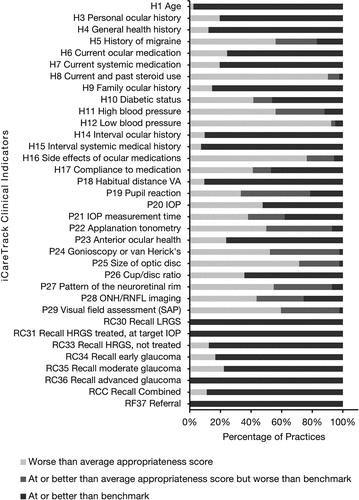Figures & data
Table 1. Steps involved in calculating Achievable Benchmarks of Care.Citation12.
Table 2. Ranking of locations by APF proportion (step 2) for iCaretrack clinical indicator of Peripheral anterior chamber assessment by gonioscopy or van Herick’s. Cumulative total of sequential addition of eligible patient encounters to determine a subset of 10% eligible patient encounters (shown in grey). ‘Yes’ indicates number of patient encounters that met indicator criteria and ‘No’ indicates number of eligible patient encounters that did not meet the indicator criteria for that indicator (step 2).
Table 3. Characteristics of the optometry practices (n = 42) and glaucoma patients (n = 42) in the iCaretrack study.Citation9.
Table 4. The iCaretrack appropriateness levels with corresponding Achievable Benchmarks of Care for glaucoma care delivery in Australia.
Figure 1. iCaretrack practice appropriateness scores benchmarked against the benchmarks for glaucoma care clinical indicators. The percentage of practices are shown for at or better than benchmarks (black), at or better than average appropriateness score but worse than the benchmark (dark grey), and worse than average appropriateness score (light grey).

